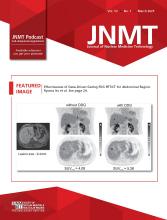Abstract
When adverse radiation incidents occur in nuclear medicine in Australia they are reported to the relevant state or territory authorities who investigate the incident and report their findings to the Australian Radiation Protection and Nuclear Safety Agency (ARPANSA). The data is then compiled and included in the Australian Radiation Incident Register (ARIR). The only information that has been circulated from the ARIR are the annual summary reports available on the ARPANSA website. The aims of this study was to analyse the radiation incidents included in ARIR together with the state and territory registers that are available to the public, identify the reoccurring themes in Nuclear Medicine incidents and make recommendations to minimise future incidents. Methods: All radiation incidents recorded on the ARIR as well as state and territory registers that occurred in nuclear medicine, radiation therapy and diagnostic radiography between 2003 and 2015 were analysed by a multidisciplinary team comprising of a nuclear medicine technologist, radiographer and radiation therapist. The nuclear medicine technology incidents were placed into one of 19 categories. Each category was then examined in greater detail to determine any reoccurring causes within them. By utilising this information, recommendations were able to be drawn to help prevent adverse incidents being repeated. Results: 209 nuclear medicine incidents from the ARIR and the state government registers of New South Wales, Victoria, South Australia and Western Australia were analysed. The primary cause of adverse radiation incidents in nuclear medicine in Australia was failure to comply with time-out protocols, accounting for 85.6% of all incidents. Conclusion: By analysing both the cause and rate of radiation incidents from the Australian national radiation incident register and state authority registers we have produced recommendations to prevent repeats of adverse events that have already occurred.







